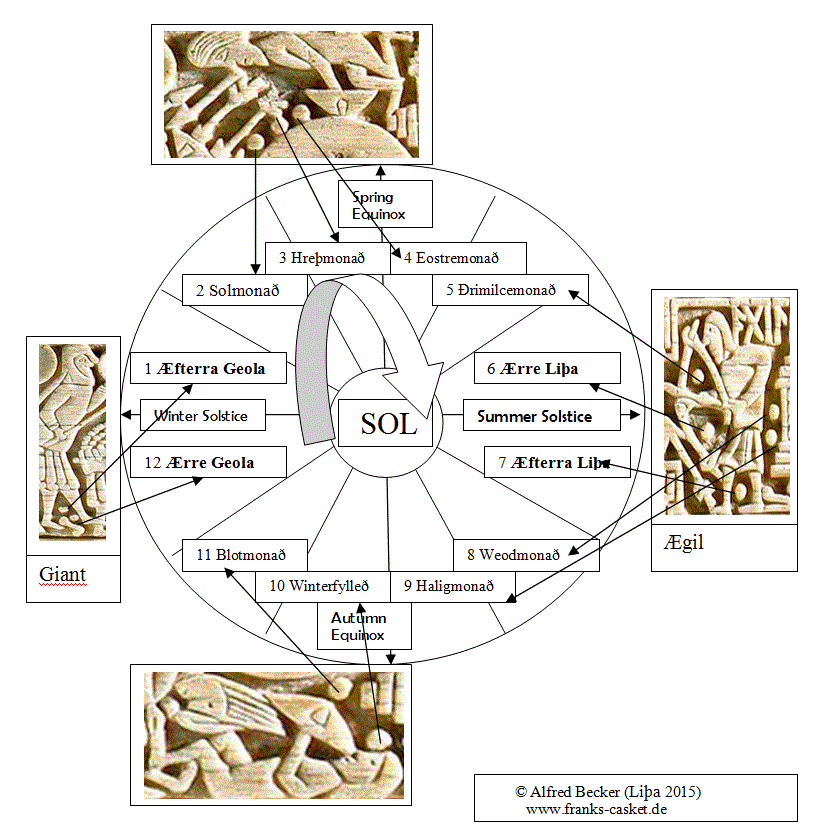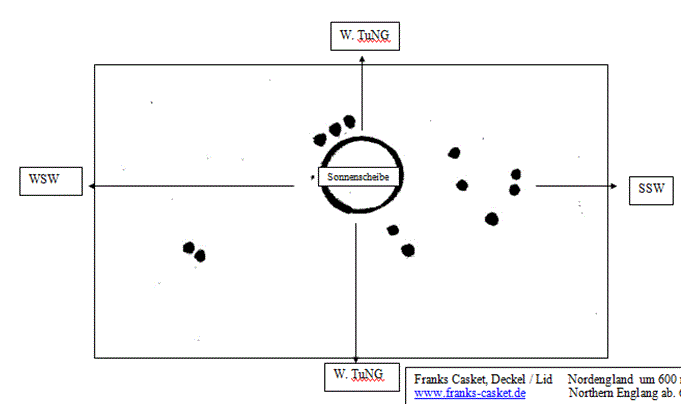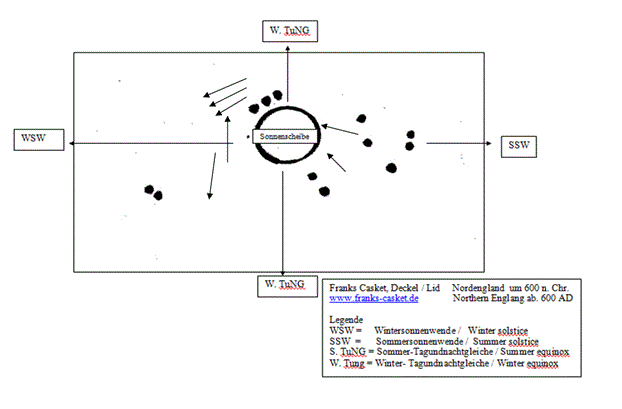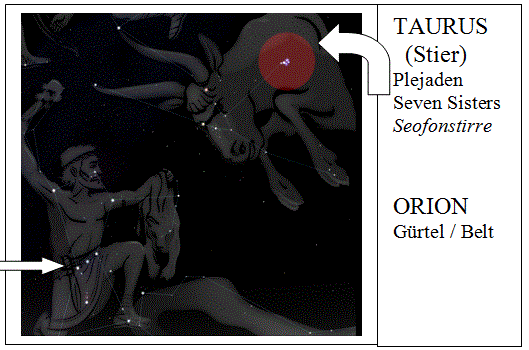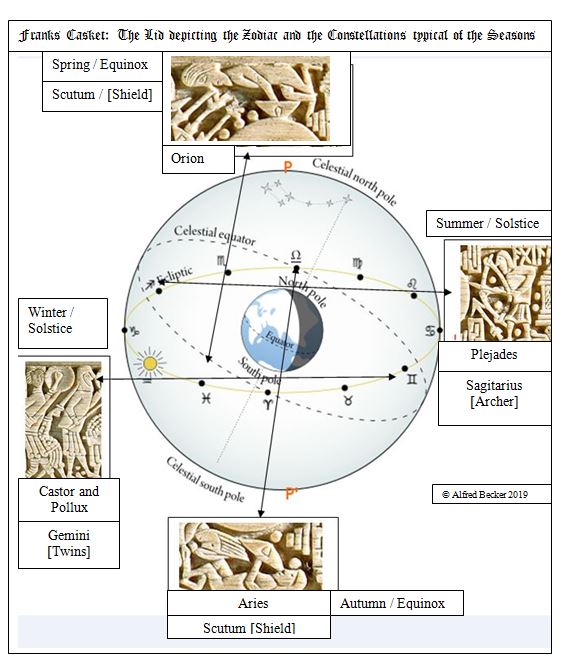|
||||||
|
The 12 months of the Solar Year
Having identified the four seasons and the days of the week we may wonder whether or not there is a reference to the 12 months of the year. As we have seen above, the rosette on the picture of the Magi alludes with its 13 rays to a lunar year1. Here now, the missing sun disk, if there was one, may have shown 12 rays, though this alone would require too much speculation. But as it is, there are 12 “dot-marks”, 5 of them along with Ægil, 3, respectively 2 with the bare defenders and two more between the feet of the giant with helmet and spear. If we regard these dots as numeric substitutes for runes we arrive at the 12th rune of the fuþark/fuþorc,
If we now equate runes (or rather their numeric substitutes) with months we begin with the marks between the giant’s feet.
The 5th and 6th months, Ðrimilcemonaðand Ærre LiÞa, are allocated to Ægil. They lead up to the period of the Summer Solstice, known as Liþa. As before with Geol, we distinguish between Ærre and Æfterra Liþa (6th and 7th month). The dot-mark between the archer’s feet indicates the solstice just as it is with the marks (separated by The autumn equinox comes at the end of the 9th month, Haligmonað, which is assigned to the bare warrior below the disc, just as Winterfylleð and Blotmonað, the 10th and 11th month. As a season (September, October, November) this is hærferst or fall.
The cycle ends with the 12th month, which is part of Geol, and therefore belongs to realm of the giant. Along with the first month of the New Year (opening with Mōdraniht), this geol -couple symbolizes Death and Rebirth. Quite obviously now, this scene illustrates the traditions around “Dies Natalis Solis Invicti” (Birthday of the Unconquered Sun).
As we can conclude now, our picture shows opposing natural powers, embodied as Deities and Giants, fighting over the Sun, once a (golden?) disk in the centre of this scene. As the Geol(Yule)-months include Winter-Solstice they are symbol of Death and Rebirth. According to the dot-marks between his feet the giant with the helmet represents the last month of the “dying” year, Ærre Geola, as he is being hit by the sword of the warrior dropping out from the battlefield. Consequently, the other giant stands for Æfterra Geola, the first month of the New Year. Their opponent is Ægil, the archer, who safeguards five of the months, Summer Solstice among them. He is backed by the deity under the arch behind him. This may be Woden/Odin, and if so, with his spear Gungnir.
Intended or not, there are 6 (if not seven) arrows “in the game”, as many as there are months between spring- and autumn-equinox, which are not under his control.
Having identified the two giants with Geol (Yule) we now turn to Ærre Geola, the one who is on the brink of death as he is being wounded from behind. It is tempting to look for Baldur, though if he ever existed in Anglo-Saxon tradition he has left no traces. He might be the one warrior hit by an arrow in the chest. But why is he among Ægil’s enemies? Such an interpretation would assume scenic presentation of mythological content. But if all figures are comprehend as emblems of the sun this fatally wounded warrior may embody – like Baldur – the dying sun at Midwinter, Blotmonað, may be. If so, all those actors represent stations of the annual course of the sun with the archer standing for stability and the Frost-Giants for chaos. Like these antagonists at solstice the bare warriors embody equinox. They do not differ very much as they represent a comparable state of the sun at equinox. The arrows shot at the Giants are meant to repel them, i.e. the deadly frost they bring about. Asgard: The Æsirs’ Heaven and the Way of Wyrd As we have seen the runic inscriptions on the panels spell 10 solar years by their number of runes and 10 lunar years by their value, both adjusted by a Metonic cycle. As 10 owns the quality of infinity it turns the composition into a “permanent calendar”. If now those pictures reflect the seasons, months and days of the week, and if the sequence of pictures depicts the stations of some king’s heroic life, it would just be consequent if some cosmic order directs the way of Wyrd, his fortune and fate. Telling it by the stars would be astrology, nevertheless, we should be able to establish more rational relations between the pictorial elements. As both sequences of pictures (i.e. the one on the panels and that on the lid) follow the course of the sun, they should correlate. If so, each panel should stand for a certain season.
The Front with the picture of the Magi stands – if not for a fourth season – for Geol and Modranect. This relation results from the Mother-with-Child motif. While Christ equates with Sol, the “Invincible Sun”, Mary adopts the part of Luna, Earth Mother
The Left Panel is next according to the course of the Sun. Here Romulus and Remus are shown as infants, being raised by the Lupa and adored by warriors on their way to war. The deity behind the scene is Þunor, who is connected with the rune
The Back Panel reports the victory of the later Roman Emperor Titus over Jews at Jerusalem. The rune
The Right Panel depicts of a warrior on the battlefield, or rather how it is brought about by his Valkyrie, who later effects his resurrection into Woden’s Valhalla. The rune
The sequence ends here with the same topic the Front starts out with, thus establishing the Cycle of Life, Death and Rebirth.
Comparing the earthly stages with their celestial analogies their parallel course is obvious. Next to Sun and Moon the stars, locum tenants of the deities rule the cosmic order. Thus the “Runic Poem” refers to The Pleiades Sisters and Orion's Belt Removing all scenic or emblematic elements from the picture on the Lid we are left with a constellation of dot marks which remind us of a starry sky, very much like that on the Nebra sky disk which is about 2000 or more years older than our object. If not simply the emblems of deities they may have served observations for farming and shipping purposes.
The concentration of 5 stars, right by the archer safeguarding the summer, reminds us of the star cluster on the Nebra sky disk, which shows a constellation of 7 stars, generally taken for the “Seven Sisters” or the Pleiades. There the profile of Celaeno, Electra and Merope is in accordance with the photo (Fig. 6)
The assumption that our star cluster may reflect the Pleiades is confirmed by correlation of months and stars (Fig 2). Their early rising (before dawn) in the second half of May (Ðrimilcemonað) designates the begin of summer, and right at this point the next 5 stars are accompanied by Ægil.
The three dot marks tangent to the disk (sun) most likely render "Orion's Belt". Some Germanic sources see interpret it as a plough stick, others as the belt of Thor, who used to drag Loki, clinging to that belt, along with him. Also in Scandinavian tradition, "Orion's belt" was known as Frigg's Distaff (friggerock) or Freyja's distaff6. As Frigg is the mother of Baldr, whose life is associated with the Sun, this tradition may be relevant for their identification.7
The two (yet unknown) stars between the feet of the first of the giants indicate the two months of Geol. We may note that the two turning points of the sun (solstices) are placed between the feet of giant an archer, respectively. This hints at a more symbolic positioning, so that this is no sky map rendering a certain time and place in history. Rather we may assume certain constellations typical of each annual season. The question remains whether or not the Sun dominates the centre of the picture, as the fight is about it, or – more realistically – the Moon, whose path at times crosses the assembly of the Seven Sisters. As it is, the picture describes the course of the solar year along with it stations at solstice and equinox. Thus it is the Sun that rules the sky. Like Heaven ruling over Earth the Lid (Asgard) covers the panels (Midgard) depicting the stages of Life, thus guiding the royal owner over days, weeks, months and years on his Way to Valhalla. As we have seen above 432000 warriors are fighting for the Sun, a mythical number which stands for the span of an aeon. In Hinduism four Yugas Srimad Bhagavatam constitute an aeon.8 Thus the scene on the Lid covers the span of the existence of the Gods and the entire creation.
1 13 months of 28 days make a year of 364 days. In this context we may note that the 13th rune counted from the end of the futhark is Y, (ger, year), vice versa number 12, counted from the beginning. This fact seems to indicate a calendar function of the fuþark.
8Wikipedia "Yuga". According to the Laws of Manu, one of the earliest known texts describing the yugas, the lengths are 4800 years + 3600 years + 2400 years + 1200 years, for a total of 12,000 years for one arc, or 24,000 years to complete the cycle, which is approximately one precession of the equinox. These 4 yugas follow a timeline ratio of (4:3:2:1). |
||||||
|
||||||
|

 The rune-like symbol
The rune-like symbol 